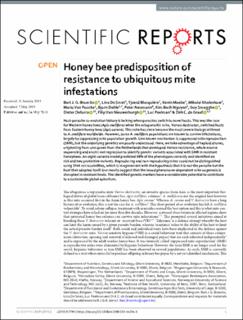| dc.contributor.author | Broeckx, Bart J G | |
| dc.contributor.author | De Smet, Lina | |
| dc.contributor.author | Blacquiere, Tjeerd | |
| dc.contributor.author | Maebe, Kevin | |
| dc.contributor.author | Khalenkow, Mikalai | |
| dc.contributor.author | Van Poucke, Mario | |
| dc.contributor.author | Dahle, Bjørn Steinar | |
| dc.contributor.author | Neumann, Peter | |
| dc.contributor.author | Bach Nguyen, Kim | |
| dc.contributor.author | Smagghe, Guy | |
| dc.contributor.author | Deforce, Dieter | |
| dc.contributor.author | Van Nieuwerburgh, Filip | |
| dc.contributor.author | Peelman, Luc | |
| dc.contributor.author | de Graaf, Dirk C. | |
| dc.date.accessioned | 2020-03-26T14:33:46Z | |
| dc.date.available | 2020-03-26T14:33:46Z | |
| dc.date.created | 2020-03-13T23:07:15Z | |
| dc.date.issued | 2019 | |
| dc.identifier.citation | Scientific Reports. 2019, 9 . | en_US |
| dc.identifier.issn | 2045-2322 | |
| dc.identifier.uri | https://hdl.handle.net/11250/2648948 | |
| dc.description.abstract | Host-parasite co-evolution history is lacking when parasites switch to novel hosts. this was the case for Western honey bees (Apis mellifera) when the ectoparasitic mite, Varroa destructor, switched hosts from eastern honey bees (Apis cerana). this mite has since become the most severe biological threat to A. mellifera worldwide. However, some A. mellifera populations are known to survive infestations, largely by suppressing mite population growth. one known mechanism is suppressed mite reproduction (sMR), but the underlying genetics are poorly understood. Here, we take advantage of haploid drones, originating from one queen from the Netherlands that developed Varroa-resistance, whole exome sequencing and elastic-net regression to identify genetic variants associated with sMR in resistant honeybees. An eight variants model predicted 88% of the phenotypes correctly and identified six risk and two protective variants. Reproducing and non-reproducing mites could not be distinguished using DNA microsatellites, which is in agreement with the hypothesis that it is not the parasite but the host that adapted itself. our results suggest that the brood pheromone-dependent mite oogenesis is disrupted in resistant hosts. The identified genetic markers have a considerable potential to contribute to a sustainable global apiculture. | en_US |
| dc.language.iso | eng | en_US |
| dc.rights | Navngivelse 4.0 Internasjonal | * |
| dc.rights.uri | http://creativecommons.org/licenses/by/4.0/deed.no | * |
| dc.title | Honey bee predisposition of resistance to ubiquitous mite infestations | en_US |
| dc.type | Peer reviewed | en_US |
| dc.type | Journal article | en_US |
| dc.description.version | publishedVersion | en_US |
| dc.source.pagenumber | 11 | en_US |
| dc.source.volume | 9 | en_US |
| dc.source.journal | Scientific Reports | en_US |
| dc.identifier.doi | 10.1038/s41598-019-44254-8 | |
| dc.identifier.cristin | 1801646 | |
| cristin.ispublished | true | |
| cristin.fulltext | original | |
| cristin.qualitycode | 1 | |

